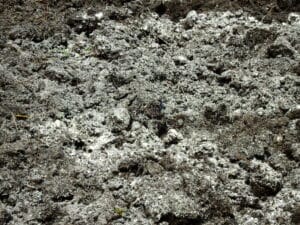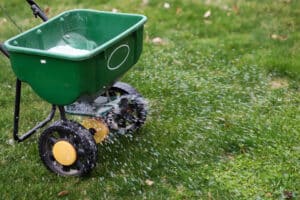If your lawn is struggling to grow due to compacted soil, you may need to aerate. Improper drainage, brown or yellow turf, and pooling after rainfall can all be signs that lawn aeration is required.
Lawn aeration involves perforating your lawn with many holes to break up the soil and let it breathe, allowing water, air, and nutrients to seep in. You can aerate on your own, but you need specialized equipment. You can also hire a lawn care company to complete this laborious task for you.
In this lawn aeration guide, we’ll break down lawn aeration costs, how the process works, when to aerate, and the top lawn care companies that provide aeration services.
Find Lawn Help
- See our list of top lawn care companies based on in-depth research.
- Select the company that best meets your needs.
- Get a free, no-obligation quote for your home.
Get a Quote From Lawn Professionals Near You
Compare quotes from local pros

Lime Soil Amendment

Lawn Fertilization
What Is Compacted Soil?
When your soil becomes compacted, it’s time to aerate. Dense and tightly packed, compacted soil inhibits root growth by cutting off access to nutrients. Soil compaction also encourages a lawn’s weed growth and makes it more vulnerable to drought. Here are some factors that might increase the likelihood of soil compaction:
- High clay content: Clay soils are more likely to become compacted than sandy soils because they’re heavier.
- New construction: If your lawn was established as part of a new home, its topsoil may be buried. Construction workers may have also stepped on and compacted the subsoil.
- Foot traffic: Lawns that get a lot of foot traffic may become compacted.
- Sod and soil layering: If you have a sod lawn, you may have soil layering—meaning the sod’s fine soil was placed on top of coarse soil when it was installed. These inconsistent layers can reduce drainage, causing compaction and making it difficult for root systems to grow.
Quick Tip
- If you’re not sure if the soil is compacted, simply pull out your toolkit and perform the screwdriver test. If you can easily slide your screwdriver several inches into your lawn’s soil surface, you’re good. If you’re met with a lot of resistance, you have compacted soil.
What Are the Benefits of Lawn Aeration?
Lawn aeration improves your lawn’s overall health by creating better conditions for roots to grow and absorb essential nutrients. Regular aeration helps grass thrive, especially in compacted or high-traffic areas.
Aeration offers several advantages, including the following:
- Enhanced root development: By giving grass roots room to expand and access to air, aeration promotes a robust root system.
- Improved fertilizer utilization: Breaks in the soil enable fertilizers to reach roots faster, optimizing nutrient uptake.
- Increased resistance to stress and drought: Healthy roots enhance the lawn’s tolerance to environmental stressors like heat and drought.
- Stronger soil structure: Aeration supports soil health and nutrient balance, strengthening soil stability.
- Thicker, greener growth: Better water, air, and nutrient uptake help with dense, lush green lawn growth.
When Should You Aerate Your Lawn?
How often you aerate depends on the conditions of your lawn. If you have sandy soil, you probably don’t need to aerate more than every two to three years. But if you have heavy clay soil, your lawn could benefit from aeration every year—or even twice a year, if it gets heavy foot traffic.
The time of year you aerate depends on your grass type. Lawn aeration is most effective during the growing season of your grass, allowing it to heal more quickly. You should aerate cool-season grasses like fine fescue and Kentucky bluegrass in early fall or early spring. Warm-season grasses like Bermuda grass and St. Augustine grass should be aerated in late spring or early summer at the latest.
Quick Tip
- You should never aerate extremely dry soil. Soil that’s a little moist is ideal—too wet, and aerating will be a mess. If you can, aerate the day after it rains, or a day after you’ve watered your lawn.
Should You Dethatch Before Lawn Aeration?
Before you start the process of lawn aeration, you’ll need to dethatch. Thatch is a layer of decomposing organic matter that sits between the grass and soil. If it builds up to a layer that’s greater than 1/2 inch, it can block your grass roots from absorbing water, air, and nutrients—just like compaction.
Dethatching is an easy process. You can use a regular rake or dethatching rake to break up and remove the thatch layer. Once you’ve removed this barrier and have a smooth surface, you can start aerating.
How To Aerate Your Lawn
If you decide to aerate the lawn yourself, you’ve got several options for tools, ranging from spiky shoes to sophisticated machinery. Your choices of aeration equipment include these:
Garden Fork
A savvy DIYer might kick things off with a simple garden fork, puncturing the soil in 3-4 inch intervals. This can be a time-consuming approach, but it’s budget-friendly. If you have a large lawn, this can get tiring quickly.
Aerator Shoes
Lawn aerator “shoes” have spikes on the bottom. You strap these spiky sandals to your regular shoes and walk around your lawn, poking holes as you go. Average aerator shoes range from $10 to $25.
Core Aerator
Also called plug aerators, core aerators cut little holes and remove “cores” or plugs of dirt from your soil through hollow tines. These plugs are usually about 2-3 inches deep, but it depends on the machine. The plugs should be removed about every 3 inches.
After removing the soil plugs from your soil, you can break them up with a rake or garden fork and leave them to decompose, adding nutrients back into the soil to promote grass growth.
Spike Aerator
Spike aerators simply puncture holes in the soil with solid tines—the same principle as aerating shoes. These aerators help a little, but they can be counterproductive. If the soil around these holes gets pressed together too closely, you’re back to square one.
Slice Aerator
These are the least common. They slice right through the grass with their blades, giving grass access to water, air, and nutrients. It’s a similar theory to spike aerators, but it doesn’t risk further compaction.
What Are Common Mistakes To Avoid When Aerating?
Lawn aeration works best when you follow the right timing and technique. Many homeowners make the mistake of aerating without checking whether the soil actually needs it. If you skip a simple soil test, like pushing a screwdriver into the ground, you may aerate unnecessarily or miss the opportunity to correct compaction.
You also need to prepare the lawn properly by mowing and watering it a day or two before aerating. Skipping prep work can make the soil too hard or dry, which limits the effectiveness of the equipment. Another common issue involves choosing the wrong size of aeration plug. Oversized plugs remove too much soil and disrupt the lawn structure.
Aerating too early or too late in the season won’t support new root growth, especially if the grass isn’t actively growing. Cool-season grasses do best with fall aeration, while warm-season varieties respond better in late spring or early summer. By avoiding these missteps, you can help your lawn fully reap the benefits of aeration.
Our Recommended Provider: TruGreen
If you don’t have the time to invest in lawn aeration or don’t want to spend money on renting or buying equipment you’ll rarely use, consider hiring TruGreen. This industry leader has been in the business since 1974 and has an A+ rating from the Better Business Bureau (BBB).
TruGreen Lawn Care Plans
TruGreen bundles its lawn aeration services into its three core annual packages to promote a healthy lawn throughout the growing season. You can find the plan breakdowns below:
| Plans | TruHealth℠ Lawn Care Plan | TruComplete℠ Lawn Care Plan | TruSignature℠ Lawn Care Plan |
|---|---|---|---|
| Fertilization | ✓ | ✓ | ✓ |
| Lime soil amendment | ✓ | ✓ | ✓ |
| Pre-emergent and targeted weed control | ✓ | ✓ | ✓ |
| Aeration | – | ✓ | ✓ |
| Overseeding | – | ✓ | ✓ |
| Tree and shrub services | – | – | ✓ |
In addition to the plans listed above, TruGreen also offers a TruNatural Lawn Care Plan for natural fertilizer, and the TruMaintenance℠ Plan, for fertilization and weeding. It also offers the following a la carte services:
- Grub prevention and control
- Fire ant control
- Soil amendment and analysis
How Can You Find Local Lawn Aeration Services?
Many homeowners prefer connecting with a locally based lawn aeration service. You may want to talk to someone who knows your area, the weather, and the best timing for the aeration process near your home. To be contacted by local professionals about your lawn, fill out this easy contact form.
FAQs About Lawn Aeration
When should I aerate my lawn?
You should aerate your lawn when it’s at the height of its growing season, helping it to heal and recover more quickly. For cool-season grasses, that’s early spring or mid-fall. For warm-season grasses, try May or June. Areas with heavy wear and tear or clay soil should be aerated each year.
Is aerating your lawn worth it?
Aerating your lawn every few years will benefit it, no matter what type of grass you have. For lawns dealing with heavy thatch, significant foot traffic, or clay soils, you may want to aerate your lawn every year.
What do you do after you aerate your lawn?
After aerating your lawn, you should take the following steps:
- Fertilize your lawn immediately for best results.
- Reseed your lawn, particularly in any thin or bare patches.
- Leave any soil plugs in the lawn to be worked back into the soil over time.
What are the benefits of aerating your lawn?
The benefits of aerating your lawn include these:
- Better use and absorption of fertilizer
- Better airflow between the soil and atmosphere
- Breakdown of thatch buildup
- Less compact soil
- Less water runoff
- Stronger roots for your turfgrass
What is the cost of aerating my lawn?
Lawn aeration costs roughly $17 per 1,000 square feet, depending on your location and service provider.





